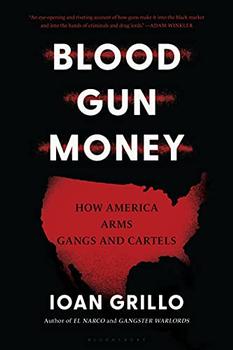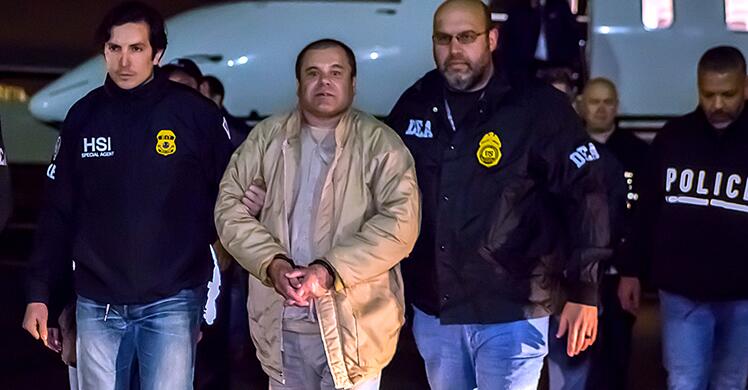Summary | Excerpt | Reviews | Beyond the Book | Read-Alikes | Genres & Themes | Author Bio

Critics' Opinion:
Readers' Opinion:
First Published:
Feb 2021, 400 pages
Paperback:
Apr 2023, 400 pages
 Book Reviewed by:
Book Reviewed by:
Scott C. Martin
Buy This Book
This article relates to Blood Gun Money
 One of the main areas of focus in Blood Gun Money is the role of drug cartels in criminal activity in Mexico. In particular, two organizations are cited multiple times: Los Zetas and the Sinaloa Cartel. Both are known for the number of enemies they've dispatched and their brutal methods of doing so. As stated in the book, guns, many of which are procured in the United States, are used by the cartels to maintain their power and status.
One of the main areas of focus in Blood Gun Money is the role of drug cartels in criminal activity in Mexico. In particular, two organizations are cited multiple times: Los Zetas and the Sinaloa Cartel. Both are known for the number of enemies they've dispatched and their brutal methods of doing so. As stated in the book, guns, many of which are procured in the United States, are used by the cartels to maintain their power and status.
The presence of drug cartels in Mexico in their modern iterations goes back decades. Most got their start as smaller, family-run organizations that oversaw the production and distribution of drugs derived from cannabis and opium. In the late 20th century, these cartels had the tacit support of the Mexican government under the administration of the Institutional Revolutionary Party (PRI).
The exact moment when the cartels started to increase their power and standing in Mexican society is up for debate, but several events in the mid-1980s and early 1990s helped sow the seeds. In the 1980s, as part of its "War on Drugs," the United States began cracking down on drug-running routes. The Colombian drug cartels primarily smuggled cocaine through the Caribbean and into South Florida. As the U.S. shut those routes down, the Colombians looked for alternative ways to get drugs into America and settled on going through Mexico. The Mexican cartels gained increased resources and power as the money from smuggling Colombian drugs filled their coffers.
In the 1990s, the Mexican cartels continued to evolve. The killing of kingpin Pablo Escobar in 1993 weakened some of the Colombian cartels, allowing the Mexican organizations to fill the void. With the signing of the North American Free Trade Agreement (NAFTA), increased avenues for trade meant greater opportunities for the smuggling of drugs into the American markets.
During this time, the Sinaloa Cartel (so named because its base of operations is in the Mexican state of Sinaloa) became one of the more powerful organizations. Under the leadership of the ruthlessly effective Joaquin "El Chapo" Guzman, the Sinaloa worked to control much of the western and central Mexican drug smuggling routes, with access to the lucrative Texas markets. They also started to take down potential rivals, especially those who challenged their rule in the west. Meanwhile, in the eastern part of Mexico, the Gulf Cartel started to assert its strength in the 1990s and 2000s, as they had access to the Gulf of Mexico trade routes and the ability to smuggle drugs into the eastern United States.
The 2000s brought significant upheaval to the political scene in Mexico, and with it, a major shift in the role and actions of the cartels. In 2000, with the election of President Vincente Fox of the National Action Party (PAN), the PRI found itself out of power for the first time in 80 years. The cartels had to modify their business models and interactions with government officials. However, plagued by corruption charges, Fox lost the next election in 2006. Once the new president, Felipe Calderon (also PAN), took office, he promised to fight the cartels and bring order to Mexico. Subsequently, he deployed military forces into known cartel strongholds. Unfortunately, instead of curtailing the cartels, the troop deployments only opened the door to increased fighting between cartels and government forces. Murder rates in Mexico skyrocketed with a total of over 120,000 killed during Calderon's administration.
As the cartels saw their power and influence grow, they also become more brazen and brutal against the opposition. Mass murders became commonplace. One group that gained particular notoriety was Los Zetas, an offshoot of the Gulf Cartel. Comprised of former paramilitary men, the Zetas made their mark with especially brutal acts, including the 2011 firebombing of a casino in Monterrey that killed 53 and the murders of 72 migrants making their way through Mexico by bus that same year. The Sinaloa Cartel's power also grew throughout Mexico, despite the on-again, off-again imprisonment of El Chapo. Even after his extradition to the U.S. in 2016, the Sinaloa Cartel still holds significant sway in Mexico. As for the Zetas, their power and influence appear to be on the wane in the past few years, but even if one group fails, there are others willing and able to fill the vacuum. According to a 2020 Congressional report, there are currently nine major drug cartels that operate in Mexico.
The cartel wars rage on with no sign of their influence or ruthlessness abating. Though primarily drug smugglers, they are diversifying their activities to include cybercrime and human trafficking. They are also moving beyond marijuana and cocaine to smuggle methamphetamines and synthetic opioids. In spite of the violence they propagate, the cartels also make an effort to support their communities, giving them a certain cachet and respect among many residents. The post-Calderon governments have promised to tackle the cartels, but their efforts have generally proven futile. The murder rate in Mexico remains high, with 2019 being the bloodiest year in recorded history, and the political and financial power of the cartels persists.
Joaquin "El Chapo" Guzman Loera, courtesy of U.S. Immigration and Customs Enforcement
Filed under Places, Cultures & Identities
![]() This "beyond the book article" relates to Blood Gun Money. It originally ran in March 2021 and has been updated for the
April 2023 paperback edition.
Go to magazine.
This "beyond the book article" relates to Blood Gun Money. It originally ran in March 2021 and has been updated for the
April 2023 paperback edition.
Go to magazine.





The Funeral Cryer by Wenyan Lu
Debut novelist Wenyan Lu brings us this witty yet profound story about one woman's midlife reawakening in contemporary rural China.
Your guide toexceptional books
BookBrowse seeks out and recommends the best in contemporary fiction and nonfiction—books that not only engage and entertain but also deepen our understanding of ourselves and the world around us.